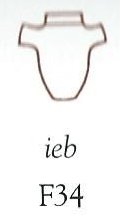119. Once again: ... Rigel (β) was at the beginning of Orion with Bet-el-Geuze - the House of the Giant, a name derived from Ibt al Jauzah, the Armpit of the Central One - at the other side, on the brink of the River. Centrally located on the Giza plateau were 3 great pyramids, like three gigantic stones for creating a new fire. Ibt (armpit) ought to be i(e)b (heart) with suffix -t for female:
... In the inscriptions of Dendera, published by Dümichen, the goddess Hathor is called 'lady of every joy'. For once, Dümichen adds: Literally ... 'the lady of every heart circuit'. This is not to say that the Egyptians had discovered the circulation of the blood. But the determinative sign for 'heart' often figures as the plumb bob at the end of a plumb line coming from a well-known astronomical or surveying device, the merkhet. Evidently, 'heart' is something very specific, as it were the 'center of gravity' ... See Aeg.Wb. 2, pp. 55f. for sign of the heart (ib) as expressing generally 'the middle, the center' ...
In the C text we can find 4 'armpit hearts', not the single one at Betelgeuze but a pair at Beid (the Egg) and another pair at Ain (the Eye). A pair of pairs suggest counting according to the Moon, because she has a pair of phases (waxing and waning) and each such face carries a pair of weeks:
When Betelgeuze rose with the Sun at the Julian equinox (84) this was 26 (= 84 - 58) days after the Egg (= ο¹ Eridani).
From Betelgeuze to Spica there were then *202 - *88 = 114 days. i.e. from the Egg to Spica there were 26 + 114 = 140 days (20 weeks).
... The Gilbert Islanders are Polynesians, having emigrated, according to their traditions, from Upolu, Samoa, which they look upon as te buto (Maori pito), the Navel of the World. They never counted the nights of the Moon beyond the twentieth, so far as Grimble was able to ascertain, and in the vagueness of their lunar calendar bore no resemblance to their Micronesian neighbors of the Carolines ... One of the names for east, Makai-oa, was said to be the name of a far eastern land, not an island, which their navigators had visited in ancient times. Tradition called this great land 'the containing wall of the sea, beyond the eastern horizon, a continous land spreading over north, south, and middle, having a marvelous store of all sorts of food, high mountains and rivers'. It was also called Maia-wa (wa being 'space, distant'). This is a clear reference to ancient voyages to the American coast from which the Polynesians are thought to have introduced the sweet potato into the Pacific area. The similarity of Maia to Maya may be more than a coincidence ...
The Mayas counted their Sun year (haab) as 18 * 20 + 5 = 365 days . The Gilbertese may have borrowed this idea from the Mayas, the idea of counting months as 20 nights. And 365 = 20 weeks + 245 (= the glyph number at the Egg, Ca9-17) = 20 * 7 + 11 * 20 + 5.
From heliacal Spica in day 140 counted from the Egg to Spica close to the Full Moon there were 140 + 183 = 323 days. From the Eye there were 323 - 3 = 320 (= 16 * 20) days:
... The traditions show that the residences of the king were fairly flexible. The building of new houses was obviously the result of (male) births in the royal family. In each case, the house that was built last is left to the newborn son and his mother, together with a specific servant, while the king has a new and separate residence constructed for himself ... From the birth (hanau) in Ca9-17 to hanau in Cb8-7 there were 570 - 245 = 325 days (glyphs) - alluding to 3-25 (the Julian equinox) and to the Council of Nicaea in 325 A.D. ... When the Pope rearranged the day for spring equinox from number 84 ('March 25) to number 80 (ºMarch 21) the earlier Julian structure was buried, was covered up (puo). At the same time the Pope deliberately avoided to correct the flow of Julian calendar days for what he may have regarded as 4 unneccesary leap days prior to the Council of Nicaea. Thus his balance sheet for days was in order. The day numbers counted from the equinox were increased with 4 and this was equal to allowing the 4 'unneccessary' leap days to remain in place. But he had moved spring equinox to a position which was 4 days too early compared to the ancient model ... These '4 unneccessary leap days' (prior to the Council of Nicaea) were equal in number to the precessional distance in time between the Pope and the time of rongorongo. The Gregorian calendar could therefore be easily understood by the Easter Islanders. The Pope had created a 'crooked calendar' but since his time the precession had fixed it. ... When the Pope Gregory XIII updated the Julian calendar he did not revise what had gone wrong before 325 AD (when the Council of Nicaea was held). Thus the stars were still 3-4 days 'out of tune' compared to the calendar ... the Gregorian 'canoe' was 'crooked'. His calendar was not in perfect alignment with the ancient star structure. Because he had avoided to adjust with the effects of the precession between the creation of the Julian calendar and the Council of Nicaea in 325 A.D. [The Julian equinox was in the 3rd month of the year and in its 25th day; 3-25.]
|
|||||||||||||||||||||||||||||||||||||||||||||||||||||||||||||||||||||||||||||||||||||||||||||||||||||||||||||||||||||||||||||||||||||||||||||||||||||||||||||||||||||||||||||||||||||||||||||||||||||||||||||||||||||||||||||||||||||||||||||||||||||||||||||||||||||||||||||||||||||||||||||||||||||||||||||||||||||||||||||||||||||||||

















